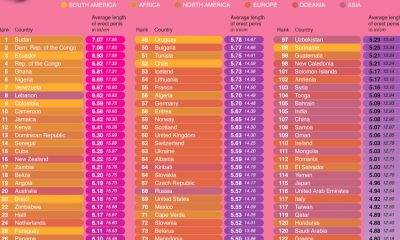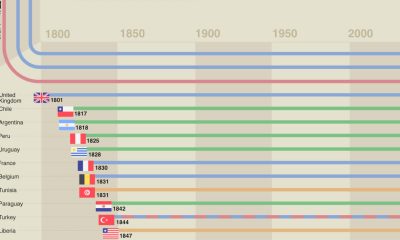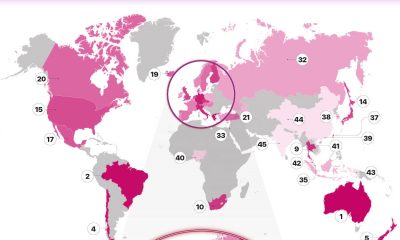Maps
Study Names One Amusement Park the Best in the Country
The United States is home to a wealth of incredible amusement parks, offering experiences for both families and adrenaline junkies. With so many options, deciding where to go can be overwhelming. Fortunately, a new chart from the Florida Rentals team ranks the nation’s top parks, making it easier to plan your next adventure.
Click below to zoom.
The rankings are based on several key factors:
- Park size
- Total attractions available
- Number of roller coasters in operation
- Themed areas within the park
- Ticket pricing
- Reviews from Google, Yelp, and TripAdvisor
Cedar Point in Sandusky, Ohio, claimed the top spot. Known as the second-oldest theme park in the country, Cedar Point boasts the highest number of mechanical rides worldwide that earned it a Guinness World Record. This iconic destination is celebrated for its legendary roller coasters, including fan favorites like Raptor, Millennium Force, Maverick, Gatekeeper, and Steel Vengeance.
The top ten parks featured in the chart include:
- Cedar Point
- Six Flags Great Adventure
- Six Flags Great America
- Kings Island
- Disney’s Animal Kingdom
- Hersheypark
- Disneyland
- Magic Kingdom
- Disney’s California Adventure
This chart serves as a handy resource for anyone planning a theme park getaway. With insights on locations, ticket prices, and standout features, it’s the ultimate tool for choosing your next thrilling escape.
Charts
Chart Shows Where Retirement Dreams Meet Financial Reality With State Ranking by Affordability
Retirement is a hard-earned chapter of life where older people can escape the daily grind of a busy workweek to focus on their health, relaxation, and quality time with loved ones. While many potential retirees dream of warm weather and sandy beaches, they’re forced to make plans based on financial realities. Many people want to know where they can stretch their savings the farthest. Each state offers its own charms and advantages, but the team at Ooma presents the real financial situation with a ranking by affordability.
Click below to zoom.
A Stark Financial Divide
Ooma’s analysis reveals dramatic differences in cost across each statement in America. They’ve determined the minimum savings needed to get by, and the results ranged from a modest $713,000 in West Virginia to a huge sum of $2.2 million in Hawaii. Their research combined nine factors to create the 400-point scoring system. Categories included savings thresholds, assisted living costs, tax burdens, memory care expenses, healthcare expenditures, and home care rates. Combined, this score reflects the true cost of retirement.
We see Hawaii emerging as the most expensive state to retire in by far. Their geographic isolation drives up the cost of living, which is common for island life. Assisted living costs are staggering, too, at $139,807 per year, and memory care reaches $11,000 a month. These costs can suck up retirement savings fast. California was the second-most expensive state, followed by Massachusetts, which both prove how steep the price of a fun lifestyle or premium healthcare can be.
The Budget-Friendly States
At the opposite end of the spectrum lies Mississippi, the most affordable state to retire in. Assisted living costs about $54,943 a year and home care costs about $25 an hour, which creates a great option for budget-conscious retirees. Alabama and Oklahoma are also on the affordable end of the spectrum, combining low living costs with affordable healthcare and tax-friendly policies.
Tax Policy Makes a Powerful Impact
State tax policies create significant cost differences between states that affect basic living expenses. Seven states on the list earned a “very tax-friendly” status due to eliminating most retirement-related taxes. These states were Alaska, Florida, Nevada, Wyoming, South Dakota, Georgia, and Mississippi. These states don’t tax retirement income or Social Security benefits and have minimal property taxes. On the other end of the scale, California, Vermont, Maine, Rhode Island, Connecticut, Minnesota, and Nebraska have the heaviest tax burdens which can eat up to 10.73% of income. These factors can’t be ignored when considering retirement costs.
Considering Healthcare Cost
Healthcare expenses are significant for aging people, and Utah has the most affordable healthcare, while New York has the most expensive healthcare. However, it’s important to consider that price often reflects healthcare quality. Massachusetts, Connecticut, and New York have the most expensive healthcare but are also the highest rated.
Paying for a Lifestyle
Despite high costs, we can see on the chart that some of the most expensive states are the most popular. Hawaii, California, and Florida are the retirement dream for anyone seeking warm weather and beautiful beaches. Luckily, research like the data presented here can help people effectively plan for whatever retirement future they dream of.
Charts
New Study is the Ultimate Guide to Snowbird Destinations
Many people find winters to be intolerably brutal, especially older people who have chronic aches and pains. The solution for many is to migrate south like the birds to soak in warmer weather and sunshine. Hence the term “snowbird!” Snowbirds escape the dreary northern weather months for the American Sun Belt. But there are many options in terms of states and counties to live in. That’s where a new study from the Florida Rentals team comes in. They created a careful analysis based on, first of all, weather, but also other important factors like cost of living and age demographics.
The study analyzed all 50 states and applied its scoring system to them. In the highest-scoring states, the team also scored specific counties in those states. The methodology weighed the weather the most heavily.
Click below to zoom.
Florida Has a Slam Dunk Snowbird Score
Florida took a healthy lead in snowbird scores, which comes as no surprise since it’s known as a snowbird paradise. The state scored 88.19 out of 100 thanks to sunshine and warm temperatures year-round, fairly low taxes, and a high population of people over 65. The Sunshine State population is 21.6% over 65, and the average winter temperatures are 59.4 degrees, and of course, no snow. These conditions draw around a million snowbirds to Florida every year, enough to increase the state population by 5% in the winter months.
As for other high-scoring states, another southern state rich in beaches, South Carolina, comes in second at 85.91 points. It’s followed by New Mexico and Arizona, both desert states, scoring 84.41 and 84.19, respectively. New Mexico and Arizona have the added bonus of low humidity, a great soother to people with chronic pain conditions like arthritis.
Choosing the Best Snowbird Counties
Many people are aware of which state they’d like to live in for the winter, but the team can help prospective snowbirds decide on a specific location with their county scores. Diving deeper into the data, we find that Florida has 60% of the top 10 high-scoring snowbird counties. Citrus County leads with a score of 88.12, a hidden gem with a high senior population, 6% sales tax rate, 60.9° F average winter temperatures, and roughly $3,563 monthly cost of living. Delve into the team’s other data to learn more about great snowbird counties.
Snowbird Scores Beyond Weather
While climate will always be the most important factor in a migration based entirely on temperature and weather, the team made sure to consider other key factors. Economics can play a huge role in a person’s decision to move. The county analysis helped in this consideration since Collier County, containing the city of Naples, Florida, is highly sought after, but the team shows us it’s also one of the most expensive locations.
Budget-conscious snowbirds might look to warm states with a low cost of living, like Arkansas, as a more affordable alternative to Florida or South Carolina. Overall, this is a comprehensive analysis of the best locations for snowbirds to flock to before the weather takes a turn for the chilly.
Charts
A Hidden Health Crisis: Where Children Drink the Most Soda
A new study from the PA Requirements team unveiled regional patterns in children’s soda consumption across the U.S. Some states have consumption rates up to five times higher than others, revealing some truly alarming statistics. The map is based on the CDC’s Youth Risk Behavior Survey, which included 42 states in a week-long analysis of soda drinking behavior. The end result is a map that paints a concerning picture of soda consumption among American children.
Click below to zoom.
West Virginia is at the top of the list, with 22.5% of high schoolers there reporting that they drank soda twice or more every day. That’s one in four West Virginia teens having several sodas every single day. Kentucky is close behind, with 18.5% of teens drinking multiple sodas, followed by Mississippi at 17.1%. These numbers seem especially high compared to the state with the lowest consumption, Massachusetts. Only 4.9% of teenagers there reported drinking multiple sodas a day.
The survey asked students to report their soda consumption with one of three answers each day: didn’t drink any soda, drank one soda, or drank two or more sodas. Responses show that children in Southern states drank the most soda.
Unfortunately, the results show us more than beverage preferences. There are a lot of health implications we can glean from these results. One soda contains 7 to 10 teaspoons of sugar, comprised of high-fructose corn syrup. For small children, the impacts of consuming so much processed sugar are even more pronounced. High sugar consumption is linked to obesity, dental disease, sleep disruption, and type 2 diabetes.
Children are also more prone to developing a sugar addiction. Drinking too much sugar leads children to develop a sugar addiction and symptoms of excessive sugar consumption, which include weight gain, mood swings, and trouble focusing.
The map colors show us a “sugar belt” across the Southern United States, with seven of the top highest consuming states located in the South. Research has shown that education impacts nutritional choices as well as income levels. Some of the states on the high end of the spectrum have lower public school ratings and high poverty levels, so it seems this isn’t coincidental. Culture may play a part as well. With many soda companies originating in the South, it might be that Southerners enjoy soda more and have normalized having a soda with meals.
Understanding soda consumption rates and health risks can help parents and educators make informed decisions about health choices for children. We don’t always realize how much soda we’re consuming until we look at hard data like this. This map and research underscore the need for soda-drinking interventions, especially in certain regions. While soda is a good treat, it’s not intended to be drunk daily, especially not for children. Through studies like this, awareness, and education, we can improve the health of American children.
-

 Business Visualizations11 months ago
Business Visualizations11 months agoEverything Owned by Apple
-

 Business Visualizations10 months ago
Business Visualizations10 months agoAmerica’s Most Valuable Companies Ranked by Profit per Employee
-

 Business Visualizations3 months ago
Business Visualizations3 months agoThe Biggest Employers by Industry
-

 Business Visualizations6 months ago
Business Visualizations6 months agoThe Biggest Fortune 500 Company in Every State
-

 Maps2 years ago
Maps2 years agoPenis Lengths Around the World
-

 Timelines2 years ago
Timelines2 years agoA History of the Oldest Flags in the World
-

 Charts2 years ago
Charts2 years agoThe Most Promiscuous Countries in the World
-

 Business Visualizations2 years ago
Business Visualizations2 years agoHow Many Companies Does Elon Musk Own?




